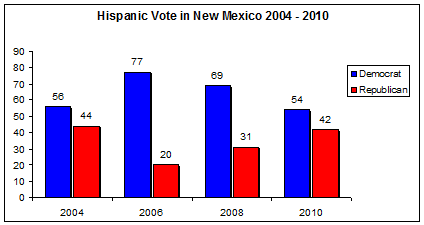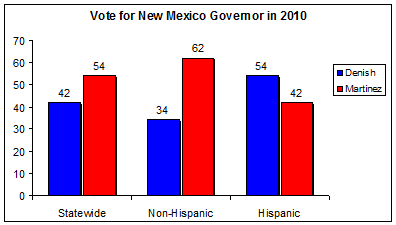By Gabriel Sanchez, Jillian Medeiros and Vickie Ybarra, University of New Mexico
With less than three weeks to go before the mid-term elections the outcome of several important races will be highly influenced by the Hispanic vote. Reports released by Latino Decisions indicate that the Latino vote will be highly influential in as many of 30 House seats, and that Latino voters will have a major say in who becomes the next Governor of the state of California. Latino voters in the state of New Mexico may also help elect the first Latina Governor in United States history, as Susana Martinez is vying to be the sixth Latino Governor of New Mexico. Unlike the current Latino Governor of New Mexico, Bill Richardson, Martinez has a Spanish surname (and first name), and more importantly is a Republican. While the neighboring state of Arizona has seen the Republican Party demonize immigrants and drive away Latinos, New Mexico is a different story. Along with Marco Rubio who is projected to win a US Senate seat in Florida and Brian Sandoval who currently has a lead in the Nevada Governor’s race, Martinez may symbolize a new and seemingly successful strategy for the Republican Party: nominate and support Latino candidates with Spanish surnames in states with heavy Latino populations.

But regardless of the outcome, the Hispanic vote will be the key once again. For the last several elections, New Mexico’s Hispanic population has constituted between 33% to 38% of the electorate, much more than in any other state, and by 2008 they accounted for an even greater segment of the voting age citizen population at 40 percent according to the U.S. Census….
Given the sheer size of the Latino electorate it is not surprising that this population has had a significant impact on the outcome of the past several elections in New Mexico. In 2008 for example, 69 percent of Latino voters supported eventual winner Barack Obama, which Latino Decisions and the National Association of Elected and Appointed Officials (NALEO) calculated gave Obama a victory margin of 117,897 votes among Hispanics in New Mexico. Bill Richardson also benefited tremendously from the Hispanic vote, as 72% percent of Latinos voted for Richardson for Governor in 2002, compared to 22% for John Sanchez (who is the running mate of Susana Martinez in this year’s race). And in 2006 Richardson coasted to re-election with an estimated 77% of the Hispanic vote in New Mexico. However in 2004 when the Hispanic vote dipped to just 56% for Kerry, the Democrat lost the state by a narrow margin. At an estimated 40% of the electorate in 2010, if the Hispanic electorate reaches the traditional 70% Democrat vote, Denish will win. However, as the polls currently indicate, Martinez may pull as much as 42% of the Hispanic vote and that will ensure her election as the first Latina Governor in the country.
The Richardson Factor
Somewhat ironically, Martinez is benefiting tremendously from Bill Richardson, the current Latino governor of New Mexico. Not due to an endorsement from Governor Richardson, but by dwindling Richardson approval ratings. Through effective campaigning which included directly challenging Richardson to a debate, Martinez has been able to effectively tie her opponent Diane Denish (the current Lieutenant Governor) to a struggling state economy and allegations of political corruption within the Richardson administration. As reflected in the table below, Martinez has been polling well from the on-set of the general election and is expanding her lead down the home-stretch. One of the dominant themes of the Martinez campaign has been to associate her opponent, Lieutenant Governor Diane Denish, with the unpopular Governor Richardson. This strategy has been reflected in several television advertisements in which Denish is labeled as a “loyal soldier” of Richardson, and in a debate this week in which Martinez said that Denish was “connected at the hip” and complicit in the corruption associated with the Richardson administration in which pay-to-play has become associated.

How quickly things have changed regarding the relationship between Richardson and the fate of the future governor of New Mexico. Two years ago Governor Richardson had just been nominated by President Obama to serve as the Commerce Secretary and Lieutenant Governor Denish was initiating plans to transition into the Governor’s role for New Mexico. The road to the Governor’s mansion was postponed for Denish however when Richardson withdrew himself from consideration, citing an investigation of a company’s business dealings with the state of New Mexico. The investigations that followed did not produce any evidence to directly tie Richardson to any illegal activity, however the growing cloud of corruption revolving around the ‘pay-to-play’ issues have undoubtedly impacted the 2010 governor’s race. The efforts of the Martinez campaign to directly connect Denish to these issues have been effective to this point in the campaign. The considerable drop in Richardson approval ratings has definitely played a role in this election, with a recent Rasmussen poll indicating that voters who disapprove of Governor Richardson’s performance are splitting heavily for Martinez. To this point Denish has not been able to establish her independence from Richardson in the minds of voters, a need that must seem incredible to those in her campaign given where things stood just two years ago.

The Impact of the Latino Vote: Group Identity and Cross-over Voting
In addition to the political baggage associated with Governor Richardson, ideological differences between the two female candidates have been a major theme in this election. The conservative tone of Martinez on immigration and other policies has helped her to secure overwhelming support from registered Republicans throughout the general election campaign, 83 percent in the most recent Albuquerque Journal Poll. Furthermore, the conservative policy platform of Susana Martinez garnered an endorsement from Sarah Palin during the Republican Primary and heavy support (94%) from those who say they are a part of the Tea Party movement, a population that is estimated by a recent Rasmussen poll to be 20% of the New Mexico electorate. The ability of a Latino Republican candidate to garner a significant share of Republican votes is far from surprising.
What is interesting however is that Martinez is polling relatively well with Hispanic voters who have voted for Democratic candidates in large numbers in recent years- see Richardson trends cited above. Specifically, although the majority of Latino voters are projected to vote for Diane Denish, recent polls have Martinez garnering between 30 and 44 percent of the Hispanic vote (see table above). This is a greater share of the Latino vote than other Republican candidates in recent memory in New Mexico, and more importantly, may well be a large enough portion of this group to help off-set a significant Democratic advantage in registered voters across the state of New Mexico. This seems to support the work of scholars who find that large numbers of minority voters will cross party lines to support a candidate of their own racial and ethnic background when given a chance. In particular, Manzano and Sanchez (2010) find that while candidate quality significantly mitigates collective ethnic political behavior, Latinos with strong ethnic attachments remain inclined to prefer a co-ethnic even when less qualified than a non-Latino candidate. Assuming the non-Hispanic vote continues to trend in favor of Martinez by a large margin, the Hispanic vote would need to break about 70-30 in favor of Denish for the Democrat to win — something that occurred in 2002, 2006, and 2008 all years the Democrats won statewide. However if Martinez captures about 40% of the Hispanic vote she will almost certainly be elected Governor.
This race may prove to be a useful test of the cross-over vote theory, as Martinez is a candidate with no state-wide political experience, especially when compared with Denish’s 8 years of experience as second-in-command for New Mexico. Although the majority of Latino voters in New Mexico (as reflected in pre-election polls) appear to be basing their votes on candidate experience and partisanship, it appears as though co-ethnicity may be the “plus factor” described by Manzano and Sanchez (2010) for a sizable and electorally significant segment of Latino voters which could make Martinez the first Latina Governor in US history.
Finally, the ability of Martinez to connect with a relatively large number of Latino voters may seem unlikely given that she has been running a campaign that has focused on conservative immigration policies including tougher border enforcement and restriction of resources for undocumented immigrants. However, a poll conducted in early September by the Albuquerque Journal found that 67 percent oppose the current policy of providing undocumented immigrants with state issued drivers licenses, a policy that Martinez promises to end if elected, thus it appears as though Martinez has found a home for this messaging within the Hispanic population of New Mexico. Denish tried to gain traction with voters on this issue earlier this week during a televised debate by stating that Martinez’s lieutenant governor running mate (John Sanchez) had been cited in the past for hiring illegal immigrants for his roofing company. Similarly, the Denish campaign has attempted to characterize Martinez as an outsider by emphasizing that she was born in Texas. One television ad for example featuring Democratic Lieutenant Governor candidate Brian Colon referred to Martinez as “una Tejana” and suggested that Martinez, who has received large donations from Texans, is being influenced by Texas interests. Martinez addressed this issue directly during this week’s debate by suggesting that the “Tejana” focused ads are nothing more than ‘race baiting’. This is a rare example of ethnicity emerging within the general election, although Martinez did challenge Denish to a Spanish language debate, effectively emphasizing her Hispanic roots.
While it is not clear whether the projected success of Latino Republicans like Martinez, Rubio, and Sandoval is a product of this particular electoral context (unpopular Democratic administration, slumping economy etc.), these candidates may be a sign of a more long-term strategy within the Republican Party. The Latino population is widely considered a target for the Republican Party, as Latinos are a young and fast growing electorate that has shown some propensity to vote for Republican candidates. Although many Latino Decision reports have made clear that the majority of Latinos remain loyal to the Democratic Party, the Republican Party may be able to utilize this Latino candidate strategy to win races within heavy Latino jurisdictions where crossover of as few as 10 percentage points could make the difference. Consider for example that among all 74 elections taking place across the nation for either governor or US Senate in 2010, the only three Spanish-surname candidates on the ballot are all Republican nominees. The window provided the Republican Party by a sluggish economy in which Latinos disproportionately suffer and inactivity on immigration reform may therefore prove costly for the Democratic Party.
Gabriel Sanchez is an Assistant Professor of Political Science at the University of New Mexico, and Senior Fellow at the Robert Wood Johnson Center for Health Policy. He received his Ph.D. from the University of Arizona in 2005.

